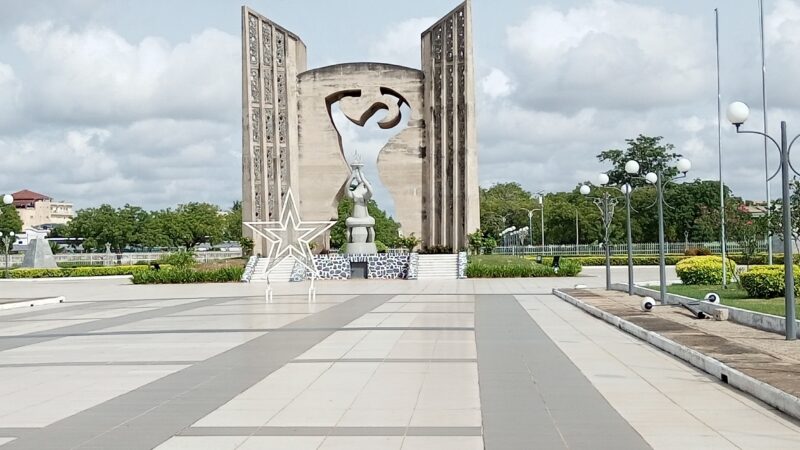
The Independence Monument in Togo's capital, Lomé. Photo by Jean Sovon. Used with permission.
There are two national languages designated in Togo's constitution: Éwé and Kabyè, which belong to the large Niger-Congo language family. Paradoxically, however, it is another language, Mina, also called Gen, that's been proven to be the language most widely spoken in the country.
There are more than 50 languages spoken in Togo, a country with a population of more than 9 million. In 1975, two languages, Éwé, which is spoken in the south, and Kabyè, spoken in the north, were adopted as Togo's national languages. Due to its colonial history, French is also designated as an official language in Togo's constitution.
From 1470 until 1960, between the periods of slavery and independence and throughout the era of colonization, the area around Togo's southern coast was subject to various foreign influences: Portuguese merchants and businessmen; German, English and French explorers. The languages spoken by these people had a considerable impact on local languages, especially on Éwé. This ultimately gave rise to a language mixed with the original Mina, the language spoken by people in the south-eastern town of Aného, 45 minutes from the capital. This language became a lingua franca that was easier for speakers of other languages to learn, and facilitated communication between different ethnic groups.
Minalingo, a platform that aims to teach internet users how to read, write and speak Mina, has proposed a word to designate this new language that melds Mina and Éwe: Miwé. In its analysis of the language, the platform explains that:
Si on me donnait l’autorité de nommer cette langue si imposante qui resserre les ficelles de l’union nationale, je l’appellerai le MIWE (miwé), car il est composé d’un grand pourcentage du vrai mina, un moyen degré d’éwé qui est férocement concurrencé par le français et un faible degré d’anglais, d’allemand et du portugais.
If I were given the authority to name this imposing language that pulls together the strings of national unity, I would call it MIWE (Miwé) because it comprises a large percentage of true Mina, an average amount of Ewé that is in fierce competition with French, and a smattering of English, German and Portuguese.
The author of the analysis laments the absence of documentation on this language which is in fact the most widely spoken in the country. He emphasizes that:
Ce qui me tracasse, ce n’est guère la fausse identification du dialecte (MIWE) au mina, mais plutôt la quasi absence de documentation et de recherche concernant ce dernier.
The thing that bothers me is hardly the false identification of the dialect (MIWE) with Mina, but rather the virtual absence of documentation and research concerning the latter.
While awaiting for official recognition of the language, however, a Togolese web series produced in 2023 is promoting this language that is so popular in Togo.
Called Ahoé (the Mina word for “country”), the web series was directed by Julio Teko and produced by Angela Aquereburu Rabatel, and financed through crowdfunding. It highlights not only this local language, but also recounts the realities faced by Togolese returning home from the West. French television network France24 recently did a news report on the series:
The 10-episode series tackles themes such as corruption, betrayal and unemployment. The first episode is shown below. The other episodes can be watched on the series’ YouTube channel.
Social media users have lauded the web series’ production team and left comments encouraging them to continue. Some reactions on X (formerly Twitter) focused on the series’ raising of awareness of the stigmatization of people with disabilities. X user Mawoussi Komlan Lab had this to say:
#Aris a rendu par son intervention justice à #Adjo et réaffirmé aux autres ces compétences.
Merci à @ahoewebserie pour ce message fort d'inclusion, de reconnaissance et de lutte contre la discrimination des personnes handicapées en milieu de travail. https://t.co/cSx9R45IM5
— MAWOUSSI Komlan Laba (@MawoussiL) January 14, 2024
#Aris through his intervention did justice to #Adjo and reaffirmed these skills to others.
Thanks to @ahoewebserie for this powerful message of inclusion, of recognition and of the fight against discrimination against disabled people in the workplace.
— MAWOUSSI Komlan Laba (@MawoussiL) January 14, 2024
To fund the production of new episodes of the web series, the Ahoé team has launched a new crowdfunding appeal and are seeking to raise at least 200 million CFA Francs (328,650 US dollars). At the time of writing, the crowdfunding site indicated that the team had already raised more than 12 million CFA Francs:
Objectif : 200 millions FCFA ⚡
À ce jour :
💰 Site: 12 250 410 FCFA
💰 Tmoney : 502 361 FCFA
💰 Flooz : 126 563 FCFAMerci du fond du cœur à tous nos contributeurs ! 🙌
Pour soutenir Ahoé : https://t.co/T3sbjD2EAb T-money : 70 50 00 00 Flooz : 96 01 01 96 pic.twitter.com/3W8lxij5Kj
— AHOÉ | La web-série (@ahoewebserie) February 12, 2024
Goal : 200 millions CFA Francs ⚡
Raised to date:
💰 Site : 12,250,410 CFA Francs
💰 Tmoney : 502,361 CFA Francs
💰 Flooz : 126,563 CFA FrancsThank you from the bottom of our hearts to all our donors! 🙌
To support Ahoé : https://t.co/T3sbjD2EAb T-money : 70 50 00 00 Flooz : 96 01 01 96 pic.twitter.com/3W8lxij5Kj
— AHOÉ | La web-série (@ahoewebserie) February 12, 2024
Up to the time of writing, the 10 episodes of the web series Ahoé had received a combined 4.5. million views on YouTube.






